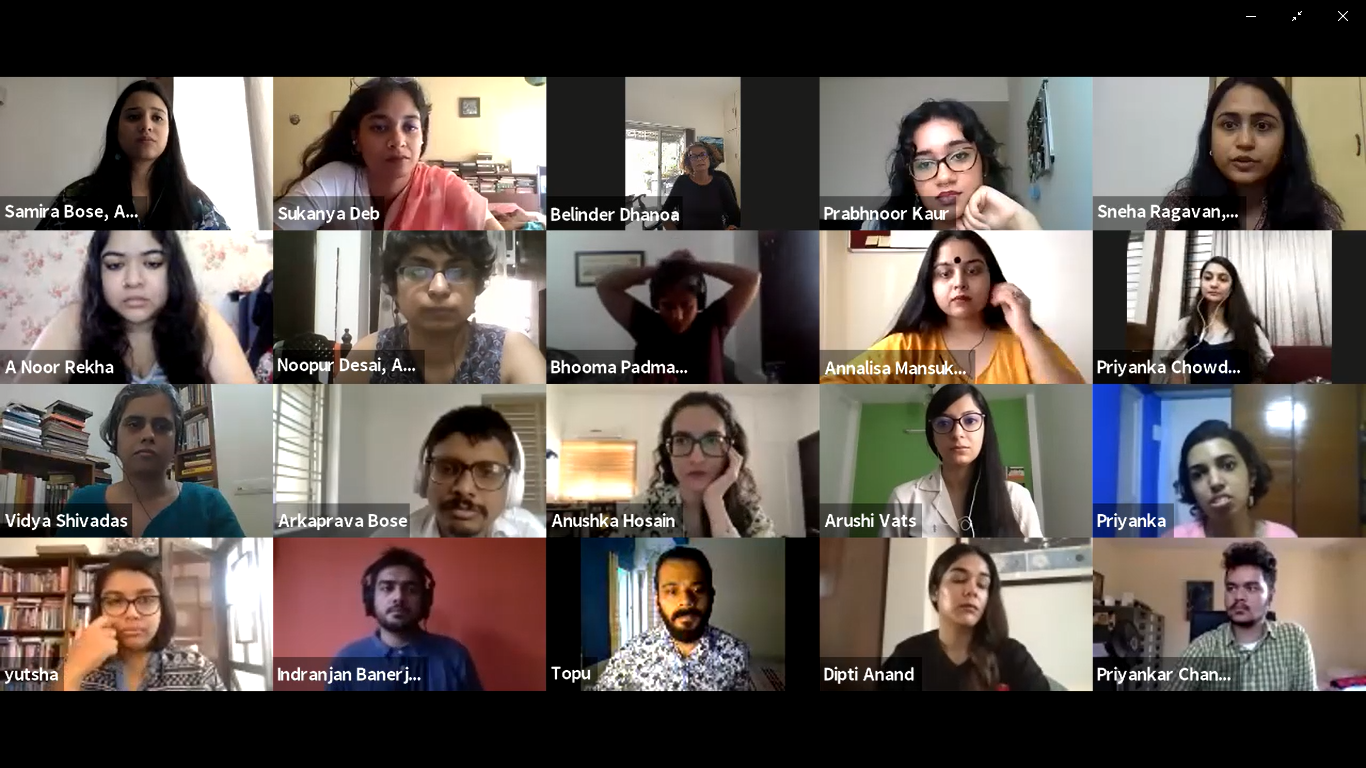Foundation for Indian Contemporary Art (FICA) and Asia Art Archive in India (AAAI) organised an online series of weekly workshops on art writing, titled Reading the Present. The workshop prompted a rethinking and re-orienting of core concerns in art writing today, and encouraged emerging writers from South Asia to think through genealogies of method, form, and vocabulary. Taking an interdisciplinary approach to writing, the workshop explored research-based writing methodologies, forms of the digital, reading and referentiality, ways of mapping textual and curatorial topographies, while also addressing the need for collaborative practices.
Each pair of sessions was structured to include one led by an invited speaker, and a follow-up session involving a practice-based framework created by them. We were honoured to have as our resource persons Belinder Dhanoa, Santhosh S., Monica Narula, Lantian Xie, Sabih Ahmed, Vidya Shivadas, Marialaura Ghidini and Rangoato Hlasane, along with Diwas Raja of Nepal Picture Library. The workshop incorporated reflective writing exercises, peer-led critique sessions, and emphasised formats of collective thinking integral to sustaining and nurturing a critical writing practice.
With 19 participants and 6 observers from across South Asia, the workshop brought together early career writers, scholars, curators, and art-workers writing on and around fields of art, visual culture, and the expanse of trans-media. Sessions took place every Friday and Saturday for seven weeks, from October to December. We were thrilled to be able to facilitate what grew to be a series of conversations on references, resources, and healthy criticism, forming a small art-writing community.
Summarising the sessions
Writer and educator Belinder Dhanoa held an interactive session titled 'Art Writing? Writing on Art?' which was an introduction to the process of art writing with a focus on questions of language and form, speaking of subversive forms of essays like the 'Fictocritical'. Alongside this, the session touched upon methods, tools, and the logistics of establishing a writerly practice for oneself. Her exercise asked participants to reflect on their relationship to writing. A range of responses came through, varying from fraught and tense to intimate and intuitive. The importance of a conscious, alert practise was emphasised.
Santhosh S encouraged participants to continue thinking about art writing through a history of ideas, concepts and precepts, illuminated by the writings of philosophers and art historians such as Walter Benjamin, with a deep reading together of his formative work, 'The Work of Art in the Age of Mechanical Reproduction'. The session drew upon the functions of art writing and its protocols at different historical moments, highlighting the importance of understanding interdisciplinarity as an intensive process where writers do not limit themselves to the production of newness, but instead seek to challenge the production and validation of categories and boundaries. Through his exercise, he encouraged participants to revisit some of the concepts that Benjamin addresses through different vantage points, in order to move beyond literal and limited interpretations.
For ‘Writing in the Digital Present,’ Monica Narula and Lantian Xie began thinking through the mode of hypertextuality in writing and practice. Monica Narula introduced the idea of artistic practices that find meaning through linkages in a constant back and forth, highlighting the work of Raqs Media Collective as an example. Lantian’s interjections during the session were positioned as anecdotes, where he looked at examples of sources and ‘sauces,’ questioning notions of (il)legibility, disposition and play, as elements and modes that populate the mechanics of writing and thinking. The exercise asked participants to "break something” and this resulted in a variety of mixed media responses, ranging from audio files and zines to black-out poetry and digital collages.
Sabih Ahmed led a session titled 'Topographies of a Text', which delved into the corpus of a writer and their references - the detritus that often forms the bedrock of one’s writing. The session mapped varied trajectories in forms of writing - from lists and inventories to anthologies, from writings on walls to the scribbles on the margins of notebooks. In the afternoon, we had a great interaction with Diwas Raja KC of Nepal Picture Library, where we engaged with their Feminist Memory Project - this session was about how to read and write with archives, particularly looking at fragmentary ephemera in the personal archives of women in Nepal. As a group activity, the exercise, and Sabih also urged participants to consider the potency of incorporating more layered explorations of such marginalia.
Marialaura Ghidini and Vidya Shivadas steered the sixth speaker-led session towards a pressing question: What are the forms of writing that we encounter within the curatorial? Tackling what it means to ‘write within the curatorial form,’ the session laced together examples from key exhibitions from museums across the world in an attempt to identify and isolate modes of reading and response that supplement viewership and display. Addressing the concept of continually mediated experiences made possible by a larger web of interconnections instigated by the curatorial position, the curatorial exercises by participants brought forth varied perspectives on the possibilities of different modes and sites of display, ranging from streets to cafes and web-pages.
Rangoato Hlasane spoke about being a writer in a community, thinking of writing as a communal practice where the act of writing alongside is foregrounded, implying a symbiosis where the objects themselves are also writing. He spoke about his early years of education through experiences outside of academic circles, spotlighting his involvement in the rap movement in his city, as well as his encounters with the Karaites school of Afrikology that exposed him to the depth of indigenous African knowledge systems. His session included listening (to music), reading (album text) and writing ‘alongside,’ responding in spontaneous flow to the material. His exercise of rethinking the specificity of our deliberations on texts, music, and the visual arts highlighted the manner in which certain timelines of interactions develop through acts of reading.













